Wabanaki Confederacy
The Wabanaki Confederacy (Wabenaki, Wobanaki, translated to "People of the Dawn" or "Easterner") are a First Nations and Native American confederation of five principal nations: the Miꞌkmaq, Maliseet, Passamaquoddy, Abenaki, and Penobscot.
Wabanaki Confederacy Wabanaki Mawuhkacik | |
|---|---|
| 1680s–1862 | |
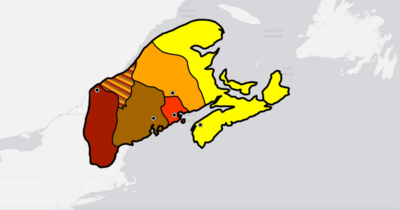 Yellow - Miꞌkmaq, Orange - Maliseet, Red - Passamaquoddy, Brown - Penobscot, Cayenne - Western Abanaki
The dots are the listed capitals, being political centers in Wabanaki. The mixed region is territory outside of the historic ranges of the five tribes. It was acquired from the Iroquois between 1541-1608 with Abanaki peoples having moved in by the time Samuel de Champlain came to the region establishing Quebec City. | |
| Capital | Panawamskek, Odanak, Sipayik, Meductic, and Eelsetkook |
| Recognised regional languages | Abenaki Malecite-Passamaquoddy Mi'kmaq English French |
| Religion | Traditional First Nations and Native American religions Christianity |
| Government | Confederation |
| History | |
• Established | 1680s |
• Disestablished | 1862 |
| Area | |
| 1680's | 349,405 km2 (134,906 sq mi) |
| Currency | Wampum United States Dollar Canadian Dollar |
| Today part of | |
Members of the Wabanaki Confederacy, the Wabanaki peoples, are in and named for the area which they call Wabanahkik ("Dawnland"), roughly the area that became the French colony of Acadia. It is made up of most of present-day Maine in the United States, and New Brunswick, mainland Nova Scotia, Cape Breton Island, Prince Edward Island and some of Quebec south of the St. Lawrence River in Canada. The Western Abenaki live on lands in New Hampshire, Vermont, and Massachusetts of the United States.[1]
History
History before formation (1520's-1680's)
.jpg)
Small scale confederacies in and around what would become the Wabanaki Confederacy were common at the time of post-Viking European contact. The earliest known Confederacy was the Mawooshen Confederacy located within the historic Eastern Penobscot cultural region. It's capital, Kadesquit, located around modern Bangor, Maine would play a significant role as a political hub for the future Wabanaki Confederacy. [3][4]
When Samual De Champlain made contact with the Mawooshen in Pemetic (Modern day Mount Desert Island, Maine) in 1604 he noted that the people actually had quite a few European goods. Post-Viking Europeans have been traveling around the region as late as the 1520's. Champlain would have a positive encounter on Petemic, and would make his way up north to the Passamaquaddy and establish a settlement on St. Cuoix Maine, and created the French colonial region Acadia on top of preexisting tribal territory. Champlain would continue to establish cities thoughout Wabanaki territory including Saint John (1604) and Quebec City(1608) among others. This would start trade and military relations between the French and the local Algonquin tribes including the Mawooshen that would last until the end of the French and Indian/Seven Year's War. [5]
The English made contact with the Mawooshen in 1605. English Captain George Weymouth would meet with them in a large village on the Kennebec river, only to kidnap 5 people to bring back to England for interrogation for places to settle by Sir Ferdinando Gorges. Of the kidnapped people, Chief Tahánedo was the only known one to be returned home. He was brought with the settlers of the short lived Popham Colony (1607-1608) in hopes to establish good relations. Local tribes would remain uncomfortable with the English colony. [6]
Soon as more French arrived as traders in modern day Nova Scotia forming the settlements like that of Port-Royal, they would more often trade weapons and other goods to the local Mi'Kmaq. Allied with the Maliseet and Passamaquoddy, they would fight with their Western Mawooshen (Abanaki/Penobscot) neighbors for goods as trading relations broke down. This power imbalance would lead to a war. In 1615 the Mi'kmaq and their allies would kill the Mawooshen Grand Chief Bashabas in his village, but soon the Mi'Kmaq, their allies, and the Mawooshen would face a widespread pandemic known as "The Great Dying" from (1616-1619) killing around 90-95% of the entire local population. [7]
When English settlers started establishing large permanent colonies in Southern New England, they would soon come into contact with a people moving into their lands in Southern Maine and New Hampshire under the colonizing efforts of people directed by Ferdinando Gorges and John Mason respectively. This would aid in establishing stronger ties between the local Algonquin people and the French, who themselves were historic rivals with the English and challenged their claims. While at the same time pushing the English closer to the Iroquois, the historic rival of the Abanaki peoples.
This tension over the next 50 years would lead up to an Algonquian uprising during King Philip's War (1675-1676) followed by the First Abenaki War (1675-1678) which would soon after bring the five tribes together in an effort to strengthen both defensive and diplomatic power, formally establishing the Wabanaki Confederacy. [8]
The Wabanaki Confederacy (1680s)
The First Abenaki War would see native peoples throughout the Abenaki lands successfully face a common and powerful enemy together, the English. All the tribes would face off with the English. The war would lead to large scale depopulation of English settlers north of the Saco River in the district of Maine, a political situation made more complicated when the Massachusetts Bay Colony was force to reliquesh control of Maine to the heirs of Ferdinando Gorges in 1676. This required them to find the heirs to buy the land making up Maine back to then issue grants for people to settle once again.
Iroquois hostilities along the Saint Lawrence River over land and resources were also becoming a bigger problem for almost all the Abenaki to organize against separately. Their usesful confederation made organization not only with theirselves, but also with their ally the English much more practical.
This would bring the tribes to form a potical union known by many names. The Mi'kmaq usually referred to it as Buduswagan (convention counci), based on the word putus (orator). Their Maliseet and Passamaquoddy neighbors also used this name. In addition, the Passamaquoddy called it Tolakutinaya (be related to one another). The Penobscot named it Bezegowak (those united into one) or Gizangowak (completely united). [9]
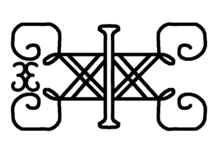
The confederacy has historically united five North American Algonquian language-speaking First Nations peoples. It played a key role in supporting the colonial rebels of the American Revolution via the Treaty of Watertown, signed in 1776 by the Miꞌkmaq and Passamaquoddy, two of its constituent tribes. Under this treaty, Wabanaki soldiers from Canada are still permitted to join the US military. They have done so in 21st-century conflicts in which the US has engaged, including the Afghanistan War and the Iraq War.
Members of the Wabanaki Confederacy are:
- (Eastern) Abenaki or Panuwapskek (Penobscot)
- (Western) Abenaki
- Míkmaq (Miꞌkmaq, L'nu)
- Peskotomuhkati (Passamaquoddy)
- Wolastoqew , Wolastoq (Maliseet or Malicite)
Nations in the Confederacy are also closely allied with the Innu and Algonquin and with the Iroquoian-speaking Wyandot. Wabanaki were also allies of the Huron in the past. Together they jointly invited the colonization of Quebec City and LaHave and the formation of New France in 1603, in order to put French guns, ships, and forts between themselves and the powerful Mohawk people to the west. Today the only remaining Huron First Nation resides mostly in the suburbs of Quebec City, a legacy of this protective alliance. In Acadia, the Wabanaki people and Acadians freely had relations and intermarriages until the Expulsion of the Acadians by the British.
The Wabanaki ancestral homeland stretches from Newfoundland, Canada to the Merrimack River valley in New Hampshire and Massachusetts, United States. This became a hotly contested borderland between the English of colonial New England and French Acadia following the European settlement in the early 17th century. Members of the Wabanaki Confederacy of Acadia participated in 7 major wars, beginning with King Phillip's War in 1675, before the British defeated the French in North America:
- King Phillip's War (1675–1678)
- King William's War (1688–1697)
- Queen Anne's War (1702–1713)
- Dummer's War (1722–1725)
- King George's War (1744–1748)
- Father Le Loutre's War (1749–1755)
- French and Indian War (1754–1763)
During this period, their population was radically decimated due to many decades of warfare, but also because of famines and devastating epidemics of infectious disease.[10]
After 1783 and the end of the American Revolutionary War, Black Loyalists, freedmen from the British colonies, were resettled by the British in this historical territory. They had promised slaves freedom if they left their rebel masters and joined the British. Three thousand freedmen were evacuated to Nova Scotia by British ships from the colonies after the war.
Many intermarriages occurred between these peoples, especially in southwest Nova Scotia from Yarmouth to Halifax. Suppression of Acadian, Black and Mi'kmaq people under British rule tended to force these peoples together as allies of necessity. Some white and black parents abandoned their mixed-race children on reserves to be raised in Wabanaki culture, even as late as the 1970s.
The British declared the Wabanaki Confederacy forcibly disbanded in 1862. However the five Wabanaki nations still exist, continued to meet, and the Confederacy was formally re-established in 1993.
Contemporary
The Wabanaki Confederacy gathering was revived in 1993. The first reconstituted confederacy conference in contemporary time was developed and proposed by Claude Aubin and Beaver Paul and hosted by the Mi'kmaq community of Listuguj under the leadership of Chief Brenda Gideon Miller. The sacred Council Fire was lit again, and embers from the fire have been kept burning continually since then.[1] The revival of the Wabanaki Confederacy brought together the Passamaquoddy Nation, Penobscot Nation, Maliseet Nation, the Miꞌkmaq Nation, and the Abenaki Nation.
Following the 2010 UNDRIP declaration (Declaration on the Rights of Indigenous Peoples), the member nations began to re-assert their treaty rights, and the Wabanaki leadership emphasized the continuing role of the Confederacy in protecting natural capital.[11]
There were meetings amongst allies,[12] a "Water Convergence Ceremony" in May 2013,[13] with Algonquin grandmothers in August 2013 supported by Kairos Canada,[14][15] and with other indigenous groups.
Alma Brooks represented the Confederacy at the June 2014 UN Permanent Forum on Indigenous Issues.[16] She discussed the Wabanaki/Wolostoq position on the Energy East pipeline.[17] Opposition to its construction has been a catalyst for organizing:
"On May 30 [2015], residents of Saint John will join others in Atlantic Canada, including Indigenous people from the Wolastoqiyik (Maliseet), Passamaquoddy and Mi'kmaq, to march to the end of the proposed pipeline and draw a line in the sand." This was widely publicized.[18]
2015 Grandmothers' Declaration
These and other preparatory meetings set an agenda for the August 19–22, 2015, meeting[19] which produced the promised Grandmothers' Declaration[20] "adopted unanimously at N'dakinna (Shelburne, Vermont) on August 21, 2015". The Declaration included mention of:
- Revitalization and maintenance of indigenous languages
- Article 25 of the United Nations Declaration on the Rights of Indigenous Peoples on land, food, and water
- A commitment to "establish decolonized maps"
- The Wingspread Statement on the Precautionary Principles
- Obligation of governments to "obtain free, prior, and informed consent" before "further infringement"
- A commitment to "strive to unite the Indigenous Peoples; from coast to coast", e.g. against Tar Sands.
- Protecting food, "seeds, waters, and lands, from chemical and genetic contamination"
- Recognizes and confirms the unique decision-making structures of the Wabanaki Peoples in accordance with Article 18 of the UN DRIP indigenous decision-making institutions:
- "Our vision is to construct a Lodge, which will serve as a living constitution and decision-making structure for the Wabanaki Confederacy."
- Recognizes the Western Abenaki living in Vermont and the United States as a "People" and member nation
- Peace and friendship with "the Seven Nations of Iroquois"
Position on ecological and health issues
On October 15, 2015, Alma Brooks spoke to the New Brunswick Hydrofracturing Commission, applying the Declaration to current provincial industrial practices:[21]
- She criticized the "industry of hydro-fracturing for natural gas in our territory" because "our people have not been adequately consulted ... have been abused and punished for taking a stand," and cited traditional knowledge of floods, quakes and salt lakes in New Brunswick;
- Criticized Irving Forestry Companies for having "clear cut our forests [and] spraying poisonous carcinogenic herbicides such as glyphosate all over 'our land', to kill hardwood trees, and other green vegetation," harming human and animal health;
- Noted "Streams, brooks, and creeks are drying up; causing the dwindling of Atlantic salmon and trout. Places where our people gather medicines, hunt deer, and moose are being contaminated with poison. We were not warned about the use of these dangerous herbicides, but since then cancer rates have been on the rise in Maliseet Communities; especially breast cancer in women and younger people are dying from cancer."
- Open pit mining "for tungsten and molybdenum [which] require tailing ponds; this one designated to be the largest in the world [which] definitely will seep out into the environment. A spill or leak from the Sisson Brook open-pit mine will permanently contaminate the Nashwaak River; which is a tributary of the Wolastok (St. John River) and surrounding waterways. This is the only place left clean enough for the survival of the Atlantic salmon."
- "Oil pipelines and "refineries ... bent on contaminating and destroying the very last inch of (Wəlastokok) Maliseet territory."
- Rivers, lakes, streams, and lands.. contaminated "to the point that we are unable to gather our annual supply of fiddleheads [an edible fern], and medicines."
- The "duty to consult with aboriginal people ... has become a meaningless process,"..."therefore governments and/or companies do not have our consent to proceed with hydro-fracturing, open-pit mining, or the building of pipelines for gas and oil bitumen."
2016
The Passamaquoddy will host the 2016 Wabanaki Confederacy Conference.
"Wabanaki Confederacy" in various indigenous languages
The term Wabanaki Confederacy in many Algonquian languages literally means "Dawn Land People".
| Language | "Easterner(s)" literally "Dawn Person(s)" |
"Dawn Land" (nominative) |
"Dawn Land" (locative) |
"Dawn Land Person" |
"Dawn Land People" or the "Wabanaki Confederacy" |
|---|---|---|---|---|---|
| Naskapi | Waapinuuhch | ||||
| Massachusett language | Wôpanâ(ak) | ||||
| Quiripi language | Wampano(ak) | Wampanoki | |||
| Miꞌkmaq | Wapnaꞌk(ik) | Wapnaꞌk | Wapnaꞌkik | Wapnaꞌki | Wapnaꞌkiyik |
| Maliseet-Passamaquoddy | Waponu(wok) | Waponahk | Waponahkik | Waponahkew | Waponahkiyik/Waponahkewiyik |
| Abenaki-Penobscot | Wôbanu(ok) | Wôbanak | Wôbanakik | Wôbanaki | Wôbanakiak |
| Algonquin | Wàbano(wak) | Wàbanaki | Wàbanakìng | Wàbanakì | Wàbanakìk |
| Ojibwe | Waabano(wag) | Waabanaki | Waabanakiing | Waabanakii | Waabanakiig/Waabanakiiyag |
| Odawa | Waabno(wag) | Waabnaki | Waabnakiing | Waabnakii | Waabnakiig/Waabnakiiyag |
| Potawatomi | Wabno(weg) | Wabneki | Wabnekig | Wabneki | Wabnekiyeg |
Maps
Maps showing the approximate locations of areas occupied by members of the Wabanaki Confederacy (from north to south):
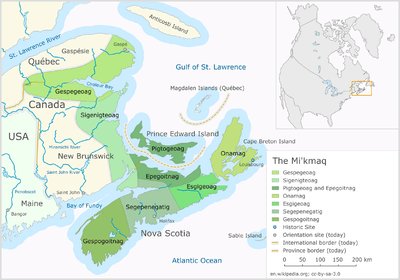 Mi'kmaq
Mi'kmaq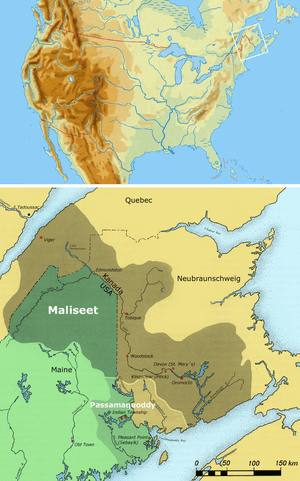
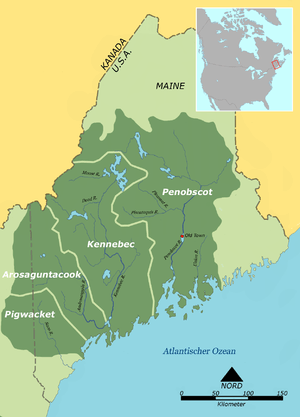 Eastern Abenaki (Penobscot, Kennebec, Arosaguntacook, Pigwacket/Pequawket)
Eastern Abenaki (Penobscot, Kennebec, Arosaguntacook, Pigwacket/Pequawket)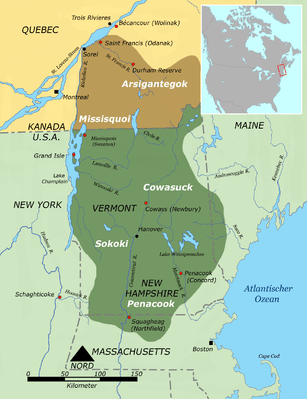 Western Abenaki (Arsigantegok, Missisquoi, Cowasuck, Sokoki, Pennacook
Western Abenaki (Arsigantegok, Missisquoi, Cowasuck, Sokoki, Pennacook
References
- Toensing, Gale Courey. "Sacred fire lights the Wabanaki Confederacy", Indian Country Today (June 27, 2008), ICT Media Network
- "Then & Now". www.vamonde.com. Retrieved August 15, 2020.
- "The Davistown Museum". www.davistownmuseum.org. Retrieved August 15, 2020.
- NORUMBEGA RECONSIDERED: MAWOOSHEN AND THE ... | Kirkus Reviews.
- Petersen, James; Blustain, Malinda; Bradley, James. ""MAWOOSHEN" REVISITED: TWO NATIVE AMERICAN CONTACT PERIOD SITES ON THE CENTRAL MAINE COAST". jstor. Eastern States Archeological Federation.
- Harald, Prins (December 2007). ASTICOU’S ISLAND DOMAIN: WABANAKI PEOPLES AT MOUNT DESERT ISLAND 1500-2000. National Park Service Boston, Massachusetts. pp. 83–84.
- "Wabanaki Timeline - The Great Dying | Research | Abbe Museum". archive.abbemuseum.org. Retrieved August 15, 2020.
- Prins, Harald. "Storm Clouds Over Wabanakiak". http://genealogyfirst.ca. Retrieved August 13, 2020. External link in
|website=(help) - Harald, Prins (2002). The Crooked Path of Dummer's Treaty: Anglo-Wabanaki Diplomacy and the Quest for Aboriginal Rights. Winnipeg: University of Manitoba: Winnipeg: University of Manitoba. p. 363.
- Prins, Harald E.L., and McBride, Bunny, "Asticou's Island Domain: Wabanaki Peoples at Mount Desert Island 1500–2000," (National Park Service, 2007)
- "Wabanaki tribes cheer UN declaration that defends their rights". Bangor Daily News — BDN Maine. Bangordailynews.com. December 19, 2010. Retrieved June 27, 2016.
- "Ally". Maine-Wabanaki REACH. Retrieved June 27, 2016.
- "Wabanaki Water Convergence ceremony – Kairos". Nationtalk.ca. May 31, 2013. Retrieved June 27, 2016.
- "Kairos Times: October 2013". Kairoscanada.org. October 15, 2013. Retrieved June 27, 2016.
- "Letter from Algonquin Grandmothers, attending Wabanaki Confederacy Conference". Nationtalk.ca. October 11, 2013. Retrieved June 27, 2016.
- Warden, Rachel (June 6, 2014). "Indigenous women unite at UN Permanent Forum on Indigenous Issues". Rabble.ca. Retrieved June 27, 2016.
- ""Energy East pipeline poses 'enormous threat' to environment:" Advocates for renewable energy hold parallel summit". NB Media Co-op. October 14, 2013. Retrieved June 27, 2016.
- "The stories of Energy East in New Brunswick | Ricochet". Ricochet.media. Retrieved June 27, 2016.
- "WABANAKI CONFEDERACY CONFERENCE" (PDF). Abenakitribe.org. August 2015. Retrieved June 27, 2016.
- "Wabanaki Confederacy Conference Statement 2015". Willinolanspeaks.com. Retrieved June 27, 2016.
- "Alma Brooks: Statements to New Brunswick Hydrofracturing Commission Oct 2015". Willinolanspeaks.com. October 18, 2013. Retrieved June 27, 2016.
Further reading
- McBride, Bunny (2001). Women of the Dawn.
- Mead, Alice (1996). Giants of the Dawnland: Eight Ancient Wabanaki Legends.
- Prins, Harald E. L. (2002). "The Crooked Path of Dummer's Treaty: Anglo-Wabanaki Diplomacy and the Quest for Aboriginal Rights". Papers of the Thirty-Third Algonquian Conference. H.C. Wolfart, ed. Winnipeg: U Manitoba Press. pp. 360–378.
- Speck, Frank G. "The Eastern Algonkian Wabanaki Confederacy". American Anthropologist, New Series, Vol. 17, No. 3 (July–September 1915), pp. 492–508
- Walker, Willard. "The Wabanaki Confederacy". Maine History 37 (3) (1998): 100–139.
External links
- Indian Treaties
- Native Languages of the Americas: Wabanaki Confederacy
- "Wabanaki People—A Story of Cultural Continuity", timeline curriculum by Abbe Museum
- Dr. Harald E. L. Prins, "Storm Clouds over Wabanakiak Confederacy Diplomacy Until Dummer's Treaty (1727)", Wabanaki Confederacy website
- Miingignoti-Keteaoag , a partnership for the way of life of the Wabanaki Nations (mirror)